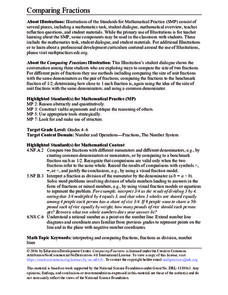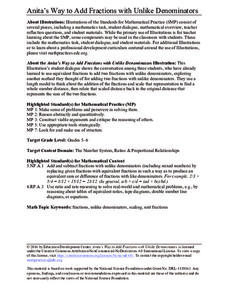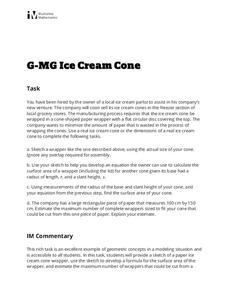Education Development Center
Comparing Fractions
Three heads are better than one. After reading a conversation between three friends about how to compare fractions, scholars analyze and discuss each presented strategy. These include using unit fractions, using benchmark fractions,...
Education Development Center
Anita's Way to Add Fractions with Unlike Denominators
Could you develop your own way to add fractions with unlike denominators? An in-depth task has scholars examine a fictional conversation between several people in which they discuss a method of adding fractions with unlike denominators....
Concord Consortium
Shooting Arrows through a Hoop
The slope makes a difference. Given an equation of a circle and point, scholars determine the relationship of the slope of a line through the point and the number of intersections with the circle. After graphing the relationship, pupils...
Illustrative Mathematics
Ice Cream Cone
Every pupil with a sweet tooth will be clamoring for this lab and analysis, particularly when they're allowed to eat the results! Volume and surface area formulas for cones are developed from models, and then extended to the printing of...
Curated OER
Identity and Equality Properties
In this math worksheet, students solve five problems, identifying each property as it is used. They identify the used property in 9 problems.
Math Mammoth
Adding Fractions And Mixed Numbers 1
In this mathematics activity, 4th graders add the fractions and shade the parts illustrated in each picture. Then they write the whole numbers from 0 to 5 under the bolded black lines. Students also add and give their answer as a mixed...
Curated OER
Illustration of the Model Method
Students understand the steps of the model method. In this model method lesson, students view each step of a problem to observe the process to solve it.
Alabama Learning Exchange
Find a Pattern Using Children's Literature
Sixth graders listen to Demi's, On Grain of Rice: A Mathematical Folktale. They use the problem solving strategy of finding a pattern to determine the number of rice Rani will receive after 30 days. They create a spreadsheet which...
Curated OER
Fish Eyes Lesson Plan
Students practice counting and matching quantities using paper fish. In this early mathematics instructional activity, students create a fake fishing pole and attempt to identify numbered paper fish they acquire from a bucket....
Curated OER
What's My Number?
Fifth graders use AppleWorks to stamp a given number to the thousandths place. They read, write and order integers, whole numbers and rational numbers. They represent place value using concrete or illustrated models.
Curated OER
Identity and Equality Properties: Pages 37-43
In this math worksheet, students use a list of mathematical properties in order to justify their evaluations. Students name multiplicative inverses and properties illustrated in 13 numbers and statements.
Curated OER
Application of Differentiation: Optimization
In this optimization worksheet, students complete a table identifying the characteristics of a function and it's derivative and provide an illustration of each type of function. Afterward, they use the first derivative test for finding...
Curated OER
How Long Does Trash Last
Young scholars work in cooperative groups to estimate how long trash lasts in a landfill. They study environmental consequences of not recycling and use graph-making software to create a graph that illustrates the lifespan of trash...
Curated OER
Indoor and Outdoor Patterns
Young scholars explore geometry by participating in a visual illustration activity. In this pattern identification lesson, students explore inside their classroom and discuss patterns they find while tracing them on paper. Young scholars...
Curated OER
Hotel Infinity
Students investigate the concept of infinity. They read a story, discuss the concept of infinity from the story, and create an illustration of the hotel described in the story.
Curated OER
Endocrine Excitement!
Young scholars are divided into a group of hormones and a group of receptors. The hormones have to find their matching receptors, and the pair, once matched, perform a given action. This activity helps students examine the specificity of...
Curated OER
Graphs
Middle schoolers participate in a lesson exploring the concept of using graphs in various types of mathematical problems. They use negative and positive numbers in order to plot a graph. Students should use a place value chart for a...
Curated OER
Spending
Students participate in a lesson that illustrates the concept of spending and how it effects the economy. Technology is integrated in this study with the use of a computer simulation of a pinball game that shows how fast money can be spent.
Curated OER
Beginning Math- Subtraction
Students practice subtraction. In this computation lesson, students learn how to subtract by watching an illustration using balls. Students are shown how to write a number sentence and complete a subtraction worksheet.
Curated OER
Angles, Bearings and Maps
In this secondary mathematics worksheet, high schoolers determine how many independent angles are in a diagram, bearings, and flight paths. The four page worksheet contains seven problems. Answers are provided.
Curated OER
Solving Multi-Step Equations (Ch. 2.3)
Eighth graders solve multi-step equations, showing each step in their solution. This multi-step equations lesson includes sample problems to complete as a class, clear step by step instructions for the student and a linked comic strip...
Curated OER
Properties of Numbers
In this algebra worksheet , students apply the properties of numbers to answer problems written in a certain way, The answer must make the property a true statement. There are 32 questions with an answer key.
Curated OER
Quiz 1-6: Commutative and Associative Properties
In this properties worksheet, students solve 8 short answer and multiple choice questions. Students determine which algebraic property is represented by the given example.
Curated OER
Properties of Operations
In this algebra worksheet, students identify different properties of integers and their operations. There are 30 questions with an answer key.























